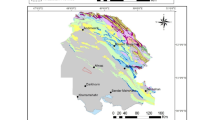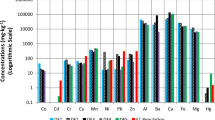Abstract
An assessment was carried out on the pollution impact potentials of drilling waste generated from wells X and Y in “Eden Field,” offshore Niger Delta. Eleven samples each were collected from well X (8 treated and 3 untreated cuttings) and well Y (6 treated cuttings and 5 spent muds). The samples were subjected to three separate analyses, namely, oil-on-cutting analysis using Dean and Stark reflux method, heavy metal analysis using atomic absorption spectrophotometer (Unicam 929), and toxicity test analysis using bioassay procedure on test organisms such as Desmoscaris trispinosa and Palaemonetes africanus all in attempt to detect their pollution potential. The results showed that the oil-on-cutting analysis for the well X samples was between 15.8 and 17.5 % for unwashed cuttings and between 4.6 and 5.1 % for washed cuttings, while that for well Y samples was between 3.49 and 4.27 % for washed cuttings and 1.69 to 2.59 % for the drill mud samples. The heavy metal analysis on the wells X and Y samples showed absence of mercury, cadmium concentration ranged from 0.52 to 0.99 mg/kg for well X and from 0.69 to 0.78 mg/kg for well Y samples. The result of the toxicity test of samples from well X on D. trispinosa showed that 96-h LC50 occurred at 9800 to 10,900 mg/l for the washed drill cutting and 6200 to 6700 mg/l for the unwashed drill cuttings. On the other hand, the toxicity test on P. africanus indicated more resistant to the toxicity of the drill cuttings as 96-h LC50 was achieved at higher concentrations. At 96-h exposure, the concentration that killed 50 % of the test organism (LC50) occurred at 14,000 to 16,900 mg/l for the washed cuttings and 10,300 to 11,350 mg/l for the unwashed cuttings. Similarly, the 96-h LC50 was achieved on washed drill cuttings from well Y at concentrations of 9800 to 10,400 mg/l using D. tripinosa and 11,600 to 17,200 mg/l using P. africanus. The study has shown that oil-on-cutting content, heavy metal concentrations, and toxicity level did not indicate any major risk to the environment as the treatment and cleaning of the drilling wastes on the rig helped in reducing the concentration of all the contaminants in compliance with the regulatory limits.




Similar content being viewed by others
References
Avbovbo AA (1978) Tertiary lithostratigraphy of Niger Delta. Bull Am Assoc Pet Geol 62:295–300
Ayers, R.C., Sauer, T.C., Meek R.P., and Bowers, G., 1980. An environmental study to assess the impact of drilling discharges in the Mid-Atlantic. Quantity and fate of discharges: pp. 382–416.
Bothner, M.H., Rendigs, R.R., Campbell, E.Y., Doughton, M.W., Parmenter, C.M., O'Dell, C.H., Dilisio, G.P., Johnson, R.G., Gillison, J.R., and Rait, N., 1985. The Georges Bank Monitoring Program: analysis of trace metals in bottom sediments during the third year of monitoring. Final Report submitted to the U.S. MMS US DOI, USGS, Woods Hole, MA. 99 pp.
Brandsma MG, Smith JP, O'Reilly JE, Ayers RC Jr., Holmquist AL (1992) Modeling offshore discharges of produced water. In: Ray JP, Englehardt R (eds) Produced water: technological/environmental issues and solutions. Plenum Press, NY, pp. 59–71
Burke K (1972) Longshore drift, submarine canyons, and submarine fans in development of Niger Delta. AAPG Bull 56:1975–1983
Canadian Association of Petroleum Producers (CAPP) (2001) Technical report of the offshore drilling waste management review report 2001–0007. Canadian Association of Petroleum Producers. Halifax, Nova Scotia, Canada 240 pp
Colborn, T., Dumanoski, D. and Myers, J.P., 1996. Our stolen future: are we threatening our fertility, intelligence and survival; Dutton: New York.156 pp.
Environmental Guidelines and Standards for Petroleum Industries in Nigeria (EGASPIN) by Department of Petroleum Resources (DPR), Revised in 2002, pp 11–21.
Evamy BD, Haremboure J, Kamerling P, Knaap WA, Molloy FA, Rowlands PH (1978) Hydrocarbon habitat of tertiary Niger Delta. AAPG Bull 62:277–298
Ifeadi, N., Ekaluo, U. and Orubuma, 1985. Treatment and disposal of drilling muds and cuttings in the Nigerian petroleum industry. Proc. International Seminar on the Petroleum Industry and Environment: Lagos.
Joint Group Experts on Scientific Aspects of Marine Environmental Protection (GESAMP), 2002. Reports and Studies No. 64; UNEP, N.Y
Lawrence SR, Munday S, Bray R (2002) Regional geology and geophysics of the eastern gulf of Guinea (Niger Delta to Rio muni). Lead Edge 21(11):1112–1117
Neff, J.M., Hillman, R.E. and Waugh, J.J., 1988b. Bioavailability of trace metals from drilling mud barite to benthic marine animals. In: Drilling Wastes, Proceedings of the 1988 International Conference on Drilling Wastes. Calgary, Alberta, Canada, Elsevier Applied Science Publishers Ltd., London, England, pp. 461–479.
Nwilo PC, Badejo OT (2005) Oil spill problems and Management in the Niger Delta. International Oil Spill Conference, Miami, Florida, USA
Oliver GA, Fischer SJ (1999) The persistence and effects of non-water based drilling fluids on Australia's North West Shelf, Progress findings from three seabed surveys. APPEA Journal, pp. 647–662
Olsgard F, Gray JS (1995) A comprehensive analysis of the effects of offshore oil and gas exploration and production on the benthic communities of the Norwegian continental shelf. Mar Ecol Prog Ser 122:277–306
Reijers TJA, Petters SW and Nwajide CS (1997) The Niger Delta Basin. In: Selly, R.C. (Ed.), African basins: Amsterdam, Elsevier Science, Sedimentary Basins of the World 3, p. 151–172.
Shell Nigeria Exploration and Production Company (SNEPCo) (2011) Draft report of Bonga Post Drill Sea Bed Survey (PDSS) submitted to Department of Petroleum Resources (DPR) June, 2011.
Short KC, Stauble AJ (1967) Outline of geology of Niger Delta. Bull Am Assoc Pet Geol 51:761–799
Verma AK, Singh TN (2013) Prediction of water quality from simple field parameters. Environ Earth Sci 69(3):821–829
Acknowledgments
The authors wish to acknowledge the leadership of Shell Nigeria Exploration and Production Company Environment team and the University Liaison of Shell Petroleum Development Company (SPDC), especially Mr. Justice Derefaka, Mr. Banjo Adeogba, Mr. Anako Osita, Mr. Harcourt Stanley, Mr. Charles Okoro, and Prof. Olayinka Ogunkoya for their support in the course of this study.
Author information
Authors and Affiliations
Corresponding author
Rights and permissions
About this article
Cite this article
Okogbue, C.O., Anyiam, O.A. & Adun, A.A. Impact assessment of drilling waste generated in “Eden Field” offshore, Niger Delta, Nigeria. Arab J Geosci 9, 538 (2016). https://doi.org/10.1007/s12517-016-2568-6
Received:
Accepted:
Published:
DOI: https://doi.org/10.1007/s12517-016-2568-6




